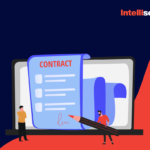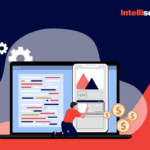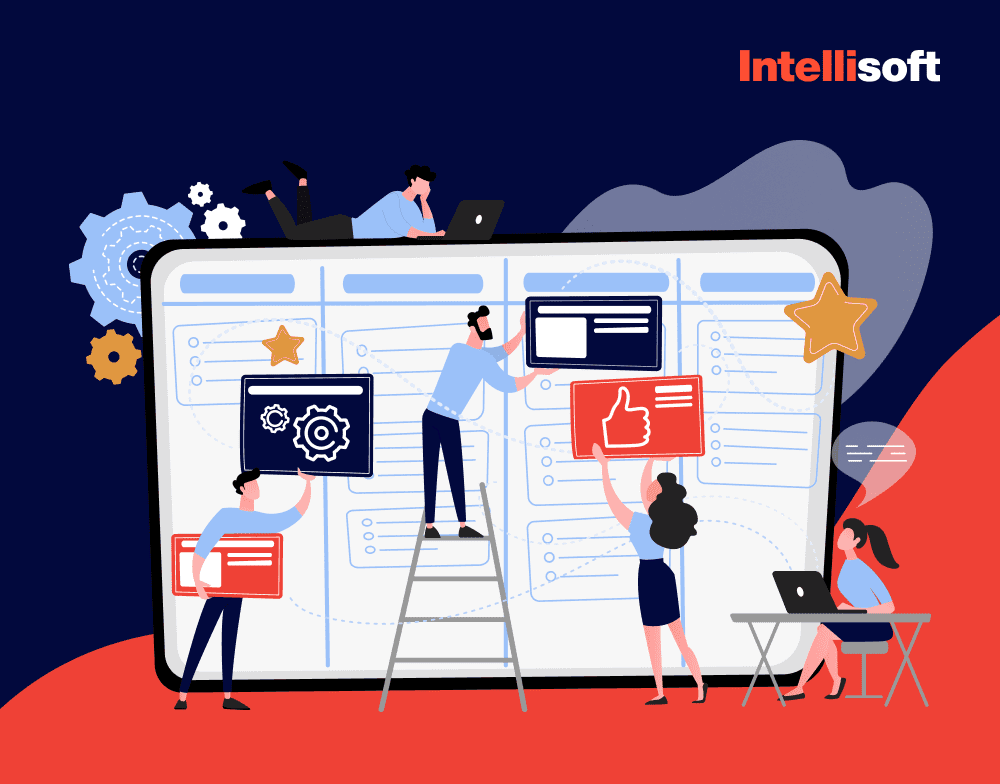Product design is crucial for creating successful products, but it’s about more than just good looks. It involves deeply understanding user needs, exceeding their expectations, and continuously refining the design. Enter iterative design—a game-changing approach that merges aesthetics with functionality. Iterative design process enables designers to craft products that are both visually appealing and highly user-friendly, focusing on the actual needs and preferences of users. In this article, we’ll dive into how iterative methodology revolutionizes the product design process and why it’s a win-win for designers and business owners alike. Let’s learn what is iterative design together!
Table of Contents
What Is Iterative Design Process?
Iterative software development is the process of software creation carried out in small steps. Iterative design is the best solution for crafting applications and similar goods for small businesses and start-ups. After all, it provides the product with bigger chances to succeed by constantly asking for user feedback and adopting the product for user needs iteration by iteration.
What is the design iterative meaning? According to the Interaction Design Foundation, the project undergoes a cycle in each development phase: Planning (Outlining) – Implementation – Testing – Evaluation (plan-do-check-act cycle). During the iterative testing, the analysis of intermediate results is carried out, new requirements are put forward, and the previous stages of work are corrected.
The budget and time required for the final version launch and maintenance are usually not initially set since the total amount of work is not defined, and the requirements are formed during implementation.
Iterative development is also known as incremental or evolutionary (with some nuances). Iterative design approach is based on the execution of tasks within “mini-projects.” Incrementality (increment for “increase”) means the sequential addition of functionality to the developed product. Learn the iterative design process diagram below.
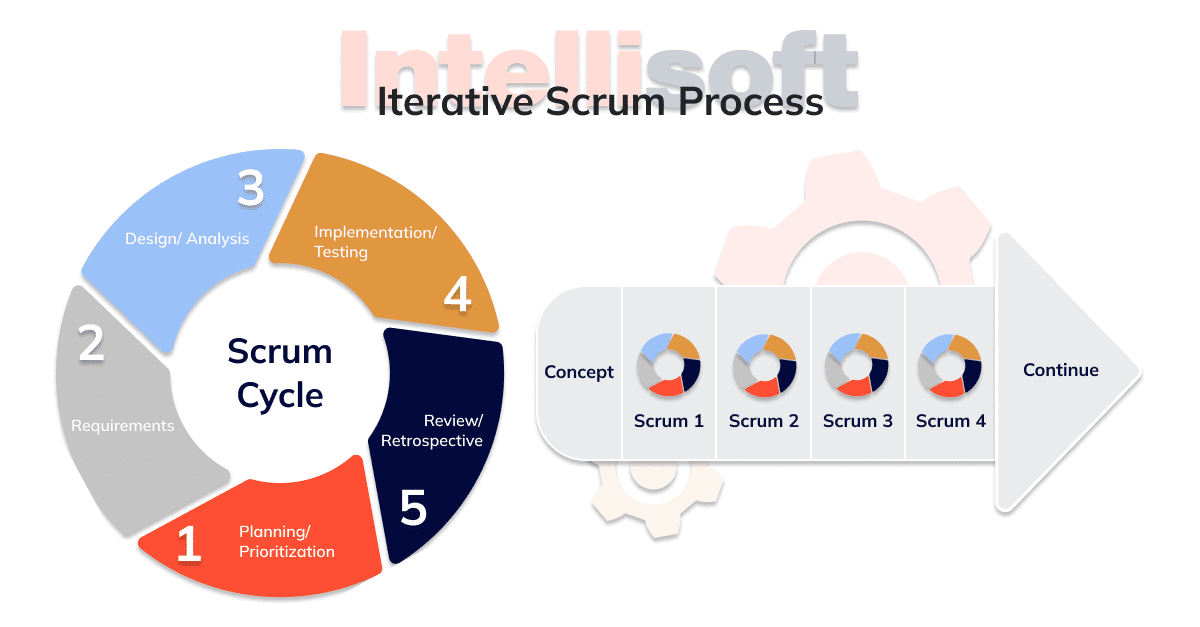
A good iterative process model example could be Wikis. They stick to the user-generated content principle. It means anyone can create entries or edit existing texts and visuals. Those who review new or updated content then have to decide whether it meets the platform’s requirements. Users expect this design iteration system to present the best available data on a given topic over time as things may change.
Why Is the Design Process Considered an Iterative Process?
Each software module undergoes separate testing stages (unit testing), but in spite of this, defects may remain for some reasons. Let’s learn the iterative process meaning:
- Since, as a rule, modules are developed by different specialists, their understanding and programming logic may differ. This is where integration testing becomes necessary to verify that modules interact with each other.
- During iterative development, customers often change requirements. If you have a tight deadline, requirements may simply lack time to pass unit testing, and consequently, the system integration can go wrong.
- The interfaces of software modules with the database may be faulty.
- External hardware interfaces, if any, may be faulty.
- Incorrect exception handling can cause problems.
Wow, plenty of good reasons, huh?
On the Adobe XD Ideas blog, Justin Morales writes:
How should one guarantee user satisfaction after using an app? Gradual iterative product testing allows you to identify usability strengths and weaknesses early on and make adjustments accordingly, potentially saving you resources in the long run. This helps pave the way for optimized interactions.”
Best Practices for Iterative Testing
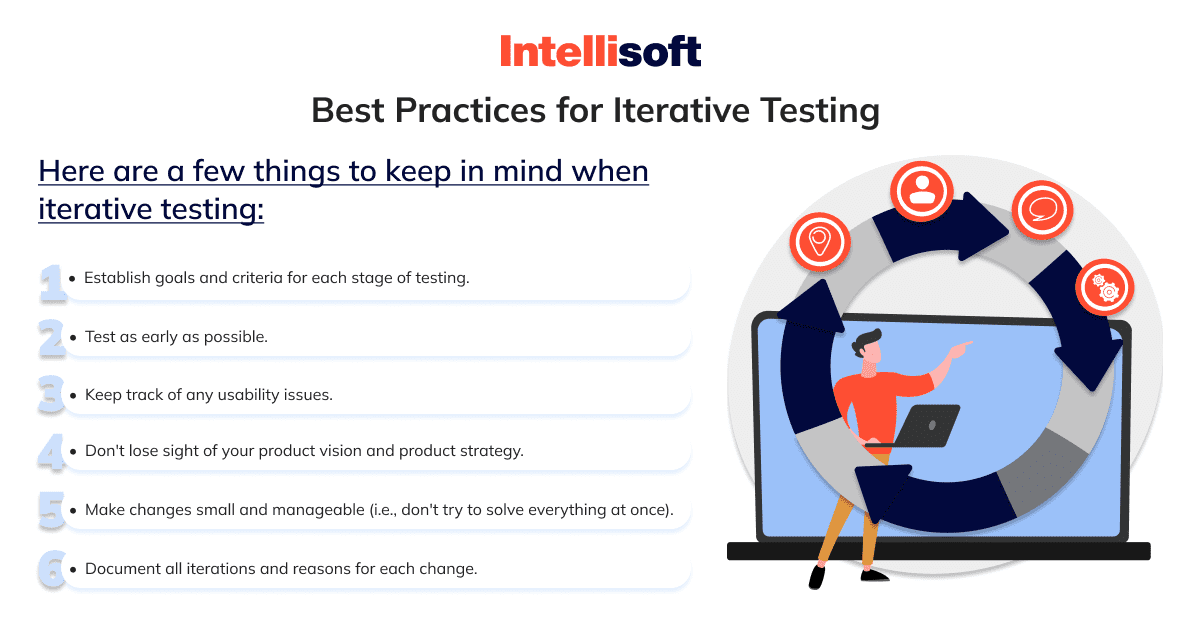
The Pros of the Iterative Development Model
Knowing the benefits of iterative design will make it easier for you to understand whether it suits you. First of all, that is risk mitigation. Second, it is about early detecting conflicts between requirements, models, and project implementation. The iterative design also means a greater focus on the main tasks. Then, it stands for dynamic requirements generation and management. Another critical advantage is the organization of effective feedback from the project team to the customer, creating a product that would offer effective solutions to the existing user problems. Finally, it is about the fast release of the minimum value product (MVP) and the ability to bring the product to market and start operating much earlier.
To sum up, here are the advantages of the iterative process
- Reducing the impact of serious risks prior to the product’s release and promotion, which leads to minimizing the cost of eliminating them.
- Organizing effective feedback from the project team to the customer (as well as stakeholders).
- Crafting a solution to the relevant user pain points.
- Focusing efforts on the most critical areas of the project.
- Evaluating the success of the project as a whole.
- Early detection of conflicts between requirements, models, and project implementation.
- A more even a load of project participants.
- Effective use of accumulated experience.
- A real assessment of the current state of the project.
- Greater confidence of customers.
The Cons of the Iterative Development Model
First, we should recall problems with architecture and overheads. When dealing with chaotic requirements without a coherent global plan, the software architecture can suffer, and additional resources may be required to bring it to an adequate form. In fact, the ability to change requirements during product creation comes at a price, one way or another.
Reiterative process has no fixed budget and deadlines, and strong involvement of the customer in the process is required. For some customers, these are unacceptable terms of cooperation with the developer, and they are better suited to the waterfall model.
What Phases Iterative Design Includes
The iterative process starts with defining customer expectations via an in-depth study. After that, a prototype is needed. At each stage, it is necessary to collect and check relevant information. Here are the steps to consider when implementing an iterative design process.
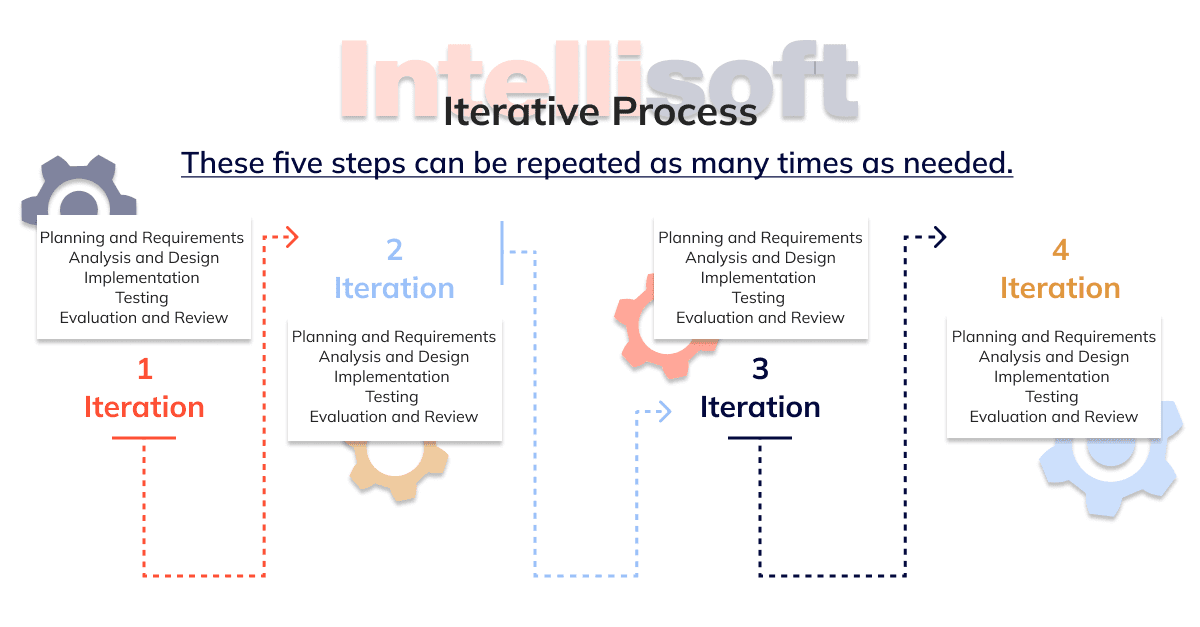
Planning
Start with preparing software requirements. A template is what comes first. A good template should include a detailed description of possible modifications.
Next, you need to decide on the writer. This person is responsible for crafting software requirements. Just one individual should take care of iterative development process. The writer should clearly, in detail, describe the necessary changes to improve the project. Before any modifications, it’s essential to detect and fix bugs.
Lastly, check everything once again and validate the data. A tech writer must not carry out the documentation without the planning phase and negotiations.
Analyzing & Designing
Conduct a study to identify the required business logic, which controls communication between the database and the end user. An analysis assists with defining workflow and business rules. Examples of the latter include:
- A user should get notifications about posts published by their fellows.
- A user has to sign in to submit a friend request.
- A user should have an opportunity to edit images in the application.
- A user must be given a chance to pick the audience who can view their pictures.
It all makes sense.
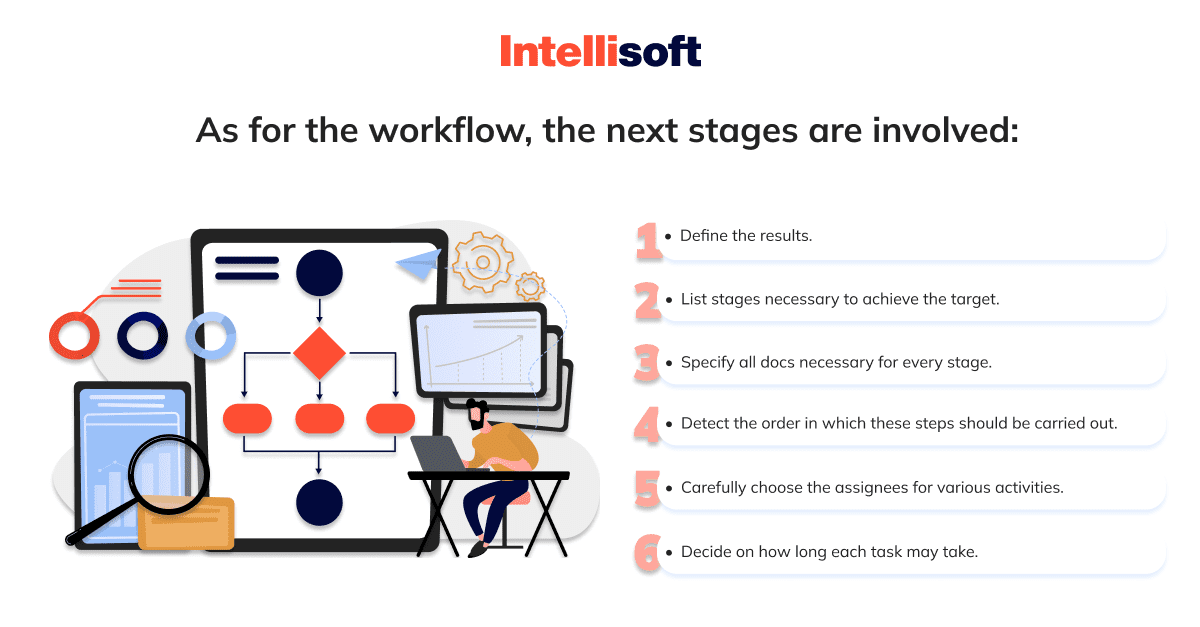
Implementation
The coding procedures start after the documentation and analysis are done. When each new iteration starts, the developers must get in touch with you to discuss what can be done in this iteration and set priorities regarding the tasks. After the product iteration, all modifications are uploaded to the staging server.
Testing
Examining the product is a must! It’s better to leave the testing process to the partner. They can assess the result critically and more objectively. Here are some tips for this stage:
- Flawless communication between the company, development team, and testing experts is required. All communication channels should be involved, including text messages, calls, and video meetings. Also, pay attention to user feedback.
- Free instruments for examination are not always sufficient. However, some extra measures may be required if they do not provide enough speed. Be ready to invest in professional paid tools.
- The next stage would be quality assurance (QA). Prior to it, check the user documentation as well.
Here is the iterative testing example. An initial version of the mobile app is developed and tested for basic functionality. Feedback is then gathered to identify areas for improvement. These improvements are implemented in the next version of the app, which is again subjected to testing. This cycle of development, testing, and refinement continues until the app reaches the desired standards of functionality and user experience.
Evaluation
The final phase is when the developers, along with the client, should test the prototype. Does it meet the expectations? If experts notice that the prototype is missing something, pass the iterative design cycle again until it all improves.
Do not forget about prototype testing, which offers a cost-effective method for ensuring products meet user requirements and regulations. These are the types of such examination to consider:
- Breadboard Testing.
- Computer Simulation.
- Force Testing.
- Decibel Testing.
- Airflow Testing.
- Dielectric Testing.
- Biocompatibility Testing.
- Sterilization Testing.
- Packaging Testing.
Pitfalls of the Iterative Design Approach
- Scope creep can decrease a project’s efficiency. If every cycle is concentrated on measurable improvements, iterative design is the most suitable option. In case the scope is poorly identified, controlling progress might be rather challenging. Another problem may arise if shareholders request more functions in an active cycle.
- The fail-quick model is intimidating. The objective of each design iteration is to detect things that do not function rapidly. Feedback loops help understand whether it is worth trying another way. This frequently means entirely tossing a design and inputting resources in another field. For markets with fast prototyping, getting shareholders on board with iterative methodology might be way more expensive.
- Perfect time management is essential. The thing is, timelines can turn somewhat flexible when a team is too concentrated on polishing a design alone. PMs have to highlight every objective and move to the testing stage as soon as goals are met.
Final Thoughts
Iterative design is a game-changer in the world of digital design. Think of your website or app as a dynamic entity, always evolving and improving, rather than a static, unchanging project.
Here’s how the iterative cycle—prototyping, testing, and refining—transforms your design process:
- Regular testing provides a goldmine of insights from real users, helping you enhance your site based on what actually works.
- Catch and address potential problems early, preventing them from becoming major headaches later on.
- Iterative development leads to better usability, ensuring your site or app performs well across all key metrics.
- This approach is far more efficient than the traditional, rigid waterfall method, allowing for flexibility and swift adaptations as you learn and grow.
Despite learning what is an iterative process, you may find it difficult to implement an iterative approach for the first time, or your project is too complex. Maybe, you will hesitate if you need this design at all. No worries – you can always consult IntelliSoft or use other company’s services to speed up your development and boost productivity. IntelliSoft is a software development company that helps start-ups build successful product prototypes and MVPs leveraging iterative design principles. Before you ever decide to have us as a partner, you may be interested in getting familiar with our previous projects and cases.
Read more handy articles for start-ups:
- 20 Main Trends in the Development of Mobile Applications in 2022
- What Is a Secure Software Development Life Cycle? Stages, Methodologies, and Best Practices
- Our Guide on How to Write Proper Software Requirements Specification (SRS)
- From Idea to Prototype: Build a Mobile App from Scratch
- A Guide on How to Recruit Software Developers: Outsource Coders vs. Freelancers
